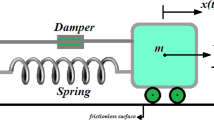Abstract
This paper presents the advances of semi-discretization approach for the dynamic stability analysis of in-feed cylindrical grinding process. The corresponding mathematical model is an autonomous delay-differential equation and the application of continuous workpiece speed variation (CWSV) in the process leads to a time-varying delay. Discretization techniques are a good way of dealing with differential equations for which the solution cannot be given in closed forms. Therefore, the semi-discretization method is proposed to analyze the equation. Stability maps are devised to study the influence of the CWSV application. Contrary to milling and turning processes, stability in grinding is very much influenced by the residual flexibility due to the deformation of the grinding wheel-workpiece system, so this term has been included in the approach. The validation has been carried out experimentally and good correlation between test and simulation results has been achieved.
Similar content being viewed by others
References
Inasaki I, Karpuschewski B, Lee H (2001) Grinding chatter— origin and suppression. CIRP Ann – Manuf Tech 50:515–534
Hahn RS (1954) On the theory of regenerative chatter in precision grinding operations. Trans ASME 76(1):593–597
Snoeys R, Brown D (1969) Dominating parameters in grinding wheel and workpiece regenerative chatter. Proceeding of the 10th International Machine Tool Design and Research Conference, Manchester, 325–348
Bartalucci B, Lisini GG (1969) Grinding process instability. ASME J Eng Ind 91(3):597–606
Inasaki I, Yonetsu S (1977) Regenerative chatter in grinding. Proceedings of the 18th International Machine Tool Design and Research Conference 423–429
Srinivasan K (1982) Application of the regenerative spectrum method to wheel regenerative chatter in grinding. ASME J Eng Ind 104:46–54
Matsubara T, Mizumoto H, Yamamoto H (1987) Experimental analysis of work regenerative chatter in grinding. Bull Jpn Soc Precis Eng 21(1):33–37
Thompson RA (1977) On the doubly regenerative stability of a grinder: the combined effect of wheel and workpiece speed. ASME J Eng Ind 99:237–241
Thompson RA (1986) On the doubly regenerative stability of a grinder: the mathematical analysis of chatter growth. ASME J Eng Ind 108:83–92
Thompson RA (1986) On the doubly regenerative stability of a grinder: the theory of chatter growth. ASME J Eng Ind 108:75–82
Thompson RA (1992) On the doubly regenerative stability of a grinder: the effect of contact stiffness and wave filtering. ASME J Eng Ind 114:53–60
Liao YS, Shiang LC (1991) Computer simulation of self-excited and forced vibrations in the external cylindrical plunge grinding process. ASME J Eng Ind 113:297–304
Biera J, Vinolas J, Nieto FJ (1997) Time domain dynamic modeling of the external plunge grinding process. Int J Mach Tools Manuf 37:1555–1572
Li H, Shin YC (2006) A time-domain dynamic model for chatter prediction of cylindrical plunge grinding processes. J Manuf Sci Eng 128:404–415
Liu Z, Payre G (2007) Stability analysis of doubly regenerative cylindrical grinding process. Journal of Sound and Vibration 301:950–962
Inasaki I, Cheng C, Yonetsu S (1976) Suppression of chatter in grinding. Bull Jpn Soc Precis Eng 9(5):133–138
Knapp BR (1999) Benefits of grinding with variable workspeed. Thesis Master of Science, The Pennsylvania State University
Barrenetxea D, Marquinez JI, Bediaga I, Uriarte L (2009) Continuous workpiece speed variation (CWSV): model based practical application to avoid chatter in grinding. CIRP Ann – Manuf Tech 58(1):319–322
Alvarez J, Barrenetxea D, Marquinez JI, Bediaga I, Gallego I (2011) Effectiveness of continuous workpiece speed variation (CWSV) for chatter avoidance in throughfeed centerless grinding. Int J Mach Tools Manuf 51:911–917
Inamura T, Sata T (1974) Stability analysis of cutting under varying spindle speed. Annals of the CIRP 23(1):119–120
Sexton JS, Stone BJ (1978) The stability of machining with continuously varying spindle speed. Annals of the CIRP 27(1):312–326
Altintas Y, Chan PK (1992) In-process detection and suppression of chatter in milling. Int J Mach Tools Manuf 32(3):329–347
Tsao TC, McCarthy MW, Kapoor SG (1993) A new approach to stability analysis of variable speed machining systems. Int J Mach Tools Manuf 33(6):791–808
Sastry S, Kapoor SG, DeVor RE (2002) Floquet theory based approach for stability analysis of the variable speed face-milling process. Trans ASME Journal of Manufacturing Science Engineering 124:10–17
Insperger T, Mann B, Stépán G, Bayly P (2003) Stability of up-milling and down-milling, part 1: alternative analytical methods. Int J Mach Tools Manuf 43:25–34
Insperger T, Stépán G (2004) Stability analysis of turning with periodic spindle speed modulation via semidiscretization. International Journal of Vibration and Control 10:1835–1855
Zatarain M, Bediaga I, Muñoa J, Lizarralde R (2008) Stability of milling processes with continuous spindle speed variation: analysis in the frequency and time domains, and experimental correlation. CIRP Ann – Manuf Tech 57(1):379–384
Sexton JS, Stone BJ (1981) The development of ultrahard abrasive grinding wheel which suppresses chatter. CIRP Ann – Manuf Tech 30(1):215–218
Ramos J (1998) Caracterización del comportamiento dinámico de máquinas-herramienta. Aplicación al rectificado cilíndrico de exteriores en penetración y al fresado frontal vertical. PhD Thesis, Universidad de Navarra
Bediaga I (2009) Supresión del chatter regenerativo mediante variación en proceso de la velocidad de giro. PhD Thesis, Escuela Superior de Ingenieros, Bilbao
Dombovari Z, Iglesias A, Zatarain M, Insperger T (2011) Prediction of multiple dominant chatter frequencies in milling processes. Int J Mach Tools Manuf 51:457–464
Giménez JG, Nieto FJ (1995) A step by step approach to the dynamic behaviour of centreless grinding machines. Int J Mach Tools Manuf 35(9):1291–1307
Author information
Authors and Affiliations
Corresponding author
Rights and permissions
About this article
Cite this article
Alvarez, J., Zatarain, M., Barrenetxea, D. et al. Semi-discretization for stability analysis of in-feed cylindrical grinding with continuous workpiece speed variation. Int J Adv Manuf Technol 69, 113–120 (2013). https://doi.org/10.1007/s00170-013-4993-y
Received:
Accepted:
Published:
Issue Date:
DOI: https://doi.org/10.1007/s00170-013-4993-y




